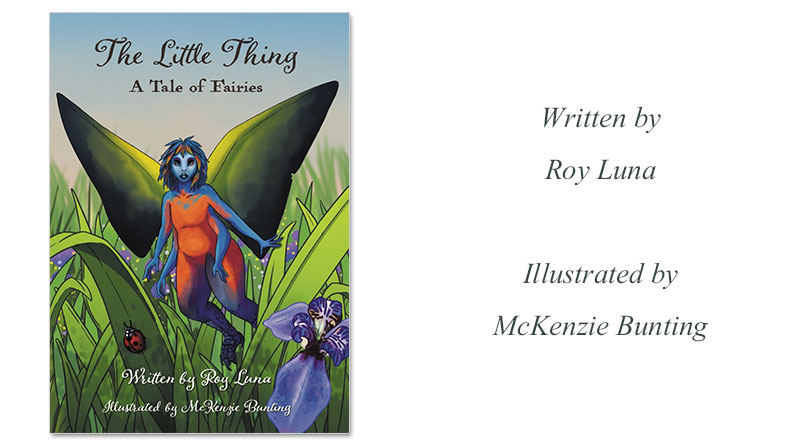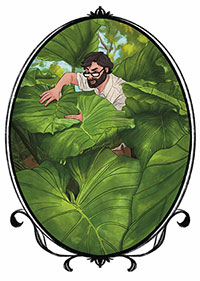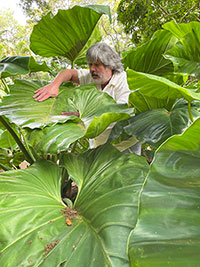New Release

Solution Hole Press introduces the first book to be published under its imprint Ten Thousand Words exclusively for illustrated books.
The Little Thing
The debate on whether fairies exist or not is now moot. Whereas they have been secretive and withdrawn in the past, they are now openly expressive, and a large percentage of them are even agressive. They are angry because they are tired of humans who have thought of the planet as their own to use and abuse, who have treated the other inhabitants with utter disrespect, who have trashed nature’s beauty, despoiled her bounty, and are the primal cause of the latest mass extinction on earth. Now, the consequences of climate change are upon us and the fairies cannot wait humans out anymore.
Having protected themselves through camouflage and mimicry for eons, fairies have started to show themselves to environmentalists in all parts of the globe. Through them, they hope to reverse some of the most egregious damages that homo sapiens have brought about to the earth. Fairies do not believe that humans are very sapiens at all. Furthermore, humans are incapable of losing the egotism that is at the center of their destruction: they think they were placed on earth to be masters over everything and everyone.
But they aren’t, according to this new intelligence that has emerged quite suddenly and is more than capable of handing the humans their comeuppance. The fairies will force the humans to comply with the new management and help with the full recovery of the planet, or else. If humans drag their feet because of indolence, indifference or ignorance, the fairies will give them an ultimatum they cannot ignore. The battle for the new managing control of the planet is on.
THE AUTHOR EXPLAINS
Why I Wrote The Little Thing
 Even for us today, nature is a source of wonder and curiosity, especially for those of us who can be troubled to find wild spaces where traces of humans are less visible. We may imagine ourselves as amateur naturalists in our little corner where nature is allowed to remain unmolested and everywhere we look we meet things that are rare and weird, often beautiful, and at times even marvelous. A fern grows: is it not awesome how its leaves unfurl from a central knob? A fragile leaf punches through the leaf litter and even pebbles with the strength of a spike, only to unfold like a soft taco. A breeze springs up, dislodging hundreds of leaves from the canopy like a shower of winking eyes. A trill of birdsong rises up and you think that it must be an act of communication but you can’t understand it. You come to a break in the canopy and a beam of sunlight streams in and there and only there you find a cloud, a swarm, a swirl of tiny gnats circling and dancing around each other and you wonder, why here? Does the sunlight keep them warm? Do they need the light to keep track of each other? Or is the sun like a klieg light shining up a stage the better for us to see their maniacal dance?
Even for us today, nature is a source of wonder and curiosity, especially for those of us who can be troubled to find wild spaces where traces of humans are less visible. We may imagine ourselves as amateur naturalists in our little corner where nature is allowed to remain unmolested and everywhere we look we meet things that are rare and weird, often beautiful, and at times even marvelous. A fern grows: is it not awesome how its leaves unfurl from a central knob? A fragile leaf punches through the leaf litter and even pebbles with the strength of a spike, only to unfold like a soft taco. A breeze springs up, dislodging hundreds of leaves from the canopy like a shower of winking eyes. A trill of birdsong rises up and you think that it must be an act of communication but you can’t understand it. You come to a break in the canopy and a beam of sunlight streams in and there and only there you find a cloud, a swarm, a swirl of tiny gnats circling and dancing around each other and you wonder, why here? Does the sunlight keep them warm? Do they need the light to keep track of each other? Or is the sun like a klieg light shining up a stage the better for us to see their maniacal dance?
From inside my house I can sometimes see the dance of the gnats beside the pool. I go out to gawk and gape. I go out to wonder: do they dance because they frolic in the happiness of living? Are evolutionary forces acting upon them and the best and most energetic of their dancers will meet and leave the party to seek nuptial privacy? I stand there and wonder.
My wonder and curiosity led me to write a piece about the mysteries of nature and our ingratitude towards her. Ever since we climbed down from the trees and left the caves we have been mistreating her. From the beginning we have wrested knowledge about her, but only to gather what we need, what we want, what we can get away with. We think that we’re victorious over Nature, but like all egotists, we do not see the truth. We don’t see the costs of all that misuse–and abuse–of our home planet. True naturalists, the environmentalists who measure the increase of world temperatures, the decrease of polar ice, the thawing of the tundra, the volume of hydrofluorocarbons and methane, the poisons in the rivers, the plastics in the oceans, those scientists have been warning us for years. But do we listen? Do we even want to listen?
 I listen, and I see. I hear the birdsong decrease; I see the trees bloom earlier each year and some that don’t bloom at all; I don’t see the nightly dance of the bioluminescent click beetles; I don’t hear the nightly calls of the tree frogs or the screech owl. Have they gone?
I listen, and I see. I hear the birdsong decrease; I see the trees bloom earlier each year and some that don’t bloom at all; I don’t see the nightly dance of the bioluminescent click beetles; I don’t hear the nightly calls of the tree frogs or the screech owl. Have they gone?
The natural world is changing and not for the best. We are told we are in the midst of another world extinction event. But the cause of this latest one is not an asteroid, not a supervolcano, not solar flares or cosmic rays. The culprit is us. We have grown more powerful, but not more intelligent. It is humans who, through ignorance and now indifference, care only for our convenience, our needs, our wants, our preferences. It’s all about us. Unfortunately, when we have finally destroyed enough of the earth to take ourselves out, we will have taken many of our earthly companion species with us into oblivion.
Is it too late? Do we throw our hands up in despair and bury our heads in the sand? Do we continue our incompetent and apathetic behavior?
Eons from now, perhaps a brighter species will find our fossils deep underground: our skeletons showing traces of mercury and cadmium, our skulls with empty eye sockets wide with surprise, our jaws set in a stupid rictus at the unfairness of the world, and in our grasping, bony hands, our car keys and a crumpled plastic bottle.
THE ILLUSTRATOR EXPLAINS
My Experience Illustrating The Little Thing:
When Roy first approached me about illustrating for The Little Thing, I was instantly fascinated with the idea of fairies existing in a modern world. Fairies were no foreign fantasy to me; my childhood days were full of them, but Roy’s approach gives a whole new life to the imagination. In a world where fairies truly exist, it only makes sense that they would have to camouflage themselves from the dangers of mankind. These last few decades have only highlighted man’s reckless tendencies when it comes to the threat of climate change.
My personal love for the environment and outdoors goes back longer than I can remember. My sister and I played “The Crocodile Hunter” before I could even fully recite the alphabet, so I equally share Roy’s passion for telling a story that emphasizes the importance of caring for our planet and treating all of its inhabitants – no matter how small – with respect and dignity. Perhaps in a different life I would have been a biologist…if so much technical science wasn’t involved! Instead, I chose to pursue art which still requires a certain focus in what I would call visual sciences: life-drawing, anatomy, creature design, plant studies, light and shadow, etc. All of the fun bits, I would say.
For this book, all of the illustrations were created in a medium known as Digital Illustration. For those unfamiliar with the concept, it is essentially a combination of traditional tools such as pencils, inks, and various paint methods, all within the form of digital “brush sets.” These brush sets are rendered through a stylus pen, tablet, and illustration software. I have hundreds of these brush sets to work with, which results in unlimited possibilities when it comes to textures, colors, and effects that would be much more difficult to accomplish with traditional methods. One major benefit to Digital Illustration is that it’s a much more forgiving medium than traditional paint and ink. With a few clicks of a button, I can erase, move, and transform things across my digital canvas without any marks or residue that would typically be left behind on a physical piece of paper.
My process begins with just the stroke of this magical pen; every illustration in this book began as just a mark on this digital canvas. Transparency was one thing that Roy and I had discussed early on, so I would typically share my illustrations in phases. The first phase was a rough concept: stick figures and general color to simply represent the scene at hand. It wasn’t much, but it was enough to start the conversation and further develop the illustration. Once Roy approved of the idea, I would move into the second phase where the concept sketch was slightly more refined, but still just general forms and placement. This was the major editing phase, as things started to take shape. The third phase involved even more refined lines, and the beginning layers of color. Eventually, more and more details starting falling into place, more color, and shadows were added. Slowly but surely, all of these images started to come to life as you will soon see in the novel.
Out of every illustration and character, I think Celesta was the most challenging character for me to conceptualize. A little fairy under the guise of a painted bunting was not something that could be easily referenced or reinvented. I remember sending Roy countless questions at the beginning of this project, what kind of feet does she have? Does she have skin, or scales, or feathers? Does she have hair like humans? How human is she? These are all some of the first questions that came to mind as an illustrator trying to create something that has never yet existed. It took several versions of Celesta before she finally reflected what Roy had imagined as the little thing. She is a creature like no other, an entirely new thing with new anatomy that was created from only words on a page. She had to be perfectly singular.
As far as my creative process goes, I most often would just plug in my headphones and hunker down in front of my tablet to work. Some illustrations were more difficult than others. Whenever a creative block would come about, I simply took a walk around the block for a breath of fresh air. I found that being outside helped to refresh a frustrated mind, and re-inspire my creativity. It might sound silly, but sometimes I really just needed to know what the world looks like from a katydid-fairy’s perspective…and what better way to figure that out than to get outside and crouch down in the dirt to see for myself? That being said, I live in Richmond, Virginia which is a significantly different terrain than the subtropical regions of Florida where our story takes place. In cases where my personal experiences and Google Images fell short, Roy provided fantastic pictures of his own garden for reference, which served as an incredible source of inspiration through every illustration. I knew Roy was going to be fantastic to work with, when he sent me pictures of himself posed in a giant Alocasia plant in his backyard – buried beneath leaves, giving me exactly what I needed for our first illustration: Rick in the Alocasia.
Lastly, I have to give my thanks and appreciation to Roy Luna himself. He has entrusted me with the responsibility of visually bringing his story to life, which has been no small task. His ideas have challenged me in the best way possible, and the illustrations have surpassed even my own expectations of myself. This is a story very close to his heart, and I have been honored to be a part of it. I was not just a hand with a pencil; throughout this entire journey together we have bounced ideas off of one another and he has encouraged me to contribute my own ideas alongside his own. My inquisitive questions were often answered with questions themselves, allowing me to experiment with my own imagination.
I can speak for the both of us when I say we are beyond thrilled to be sharing this story, and we hope you all fall in love with The Little Thing as much as we both have.
